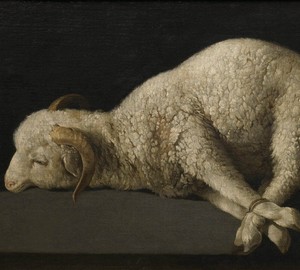
Description of the picture:
The Lamb of God – Francisco de Zurbaran. Canvas, oil. 35.6 x 52 cm
Francisco de Zurbaran, called “Spanish Caravaggio”, a master of still lifes and religious painting. All of his canvases are simple in compositional execution, he has no complicated subjects, still lifes are laconic and executed in one gamut of colors.
But anyone who sees his painting “The Lamb of God” will surely stop and freeze in admiration for the technique of execution, but to a greater extent – from the symbolic, sacred meaning that it carries in itself. After all, the animal that is intended as a sacrifice, in the Old Testament it is called the “Passover lamb,” is brought to the glory of God. And in the New Testament, John the Baptist directly points to Christ, calling him the Lamb of God (Agnus Dei), who will take on all the sin of the world.
The artist depicts a lamb as a symbol of meekness, kindness, innocence and integrity, which in Christianity endow Jesus Christ, who made a sacrifice in the name of mankind.
The paws of an animal brought to the slaughter are connected by a cross, reminding us that the son of God also died on the cross. And also, like Christ, the animal resigned itself to its fate, knowing its inevitability.
Zurbaran always wrote only from nature, and in this work he does not depart from his rules. The naturalism of the image is amazing. The overall relief of the animal is shown using deep shadows and light. His horns are convex and rosary. Eyes are half covered with bright eyelashes and reflect humility to fate. The feeling that the pale pink nose of a lamb is moist and breathable is very real.
In writing the hair of an animal, the painter simply surpasses himself – each villus and curl are so materialistic that they unwittingly want to reach out and stroke it. Of course, this work is a masterpiece of the work of Francisco de Zurbaran.
The author has written several reproductions from this picture, which indicates the genius of the artist, who was appreciated not only by descendants, but also by his contemporaries."